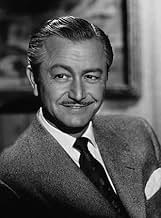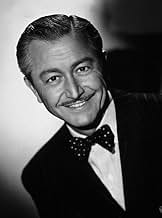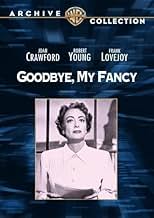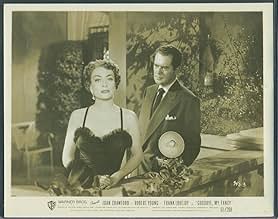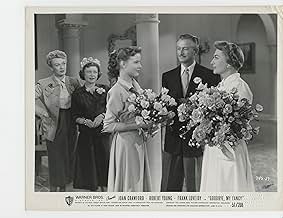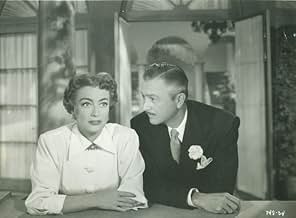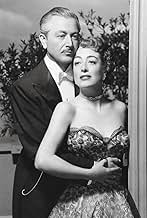ÉVALUATION IMDb
6,0/10
1 k
MA NOTE
Ajouter une intrigue dans votre langueCongresswoman returns to college to reignite romance with president, facing rival and her controversial film threatening his job.Congresswoman returns to college to reignite romance with president, facing rival and her controversial film threatening his job.Congresswoman returns to college to reignite romance with president, facing rival and her controversial film threatening his job.
- Director
- Writers
- Stars
- Prix
- 1 victoire au total
Leah Baird
- Party Guest
- (uncredited)
George Bunny
- Janitor
- (uncredited)
Mary Carver
- Joan Wintner
- (uncredited)
Beulah Christian
- Party Guest
- (uncredited)
James Conaty
- Party Guest
- (uncredited)
Frank Conlan
- Frank
- (uncredited)
Avis en vedette
As a devoted fan of old movies which were released when I was a little boy and in those days already an ardent film fan and moviegoer, I was highly surprised to see this film on TCM today because I had never heard of it. But I was certainly glad to have finally caught up with it. As the plot unfolded it became obvious that this must have been originally a finely crafted stage play from the way it led you sympathetically from one character to another and kept you in complete suspense as to different possible denouements for the action. In fact it reminded me of some of Terrence Rattigan's finer plays. But now I see that the play was written by the wife(?) of Garson Kanin. I thoroughly agree with the first review that the romantic side of the plot, though very touching, was by no means all there was to it. Strong statements on wider issues such as academic freedom, ability of big money to call the educational tune, the growing up out of illusions which must be discarded (very Ibsen or George Bernard Shaw) all were pithily and dramatically dealt with and skillfully presented to the audience. The side roles (especially Eve Arden) were all brilliantly executed in that wise-cracking, zany style that made the plays of the 1920s and 30s such favorites. And the main leads (Crawford, Young, etc) were equally outstanding in their emotional portrayals. This film was at least 10-15 years ahead of its time. When the 1960s finally rolled around American youth finally took the blinders off just the way Kanin and the makers of this film advocated. A brilliant and enthralling accomplishment. I wish we could all personally congratulate all the makers of this film of 50 years ago.
I'm glad to see that TCM has chosen to include this film in its lineup. I have, however, noted an error in the TCM and Wikipedia summaries regarding filming location. Both cite Occidental College in Eagle Rock, Calif. as the site for outdoor scene filming. In fact, most if not all were shot on the University of Redlands campus in Redlands, Calif. I attended the U. of R. for 4 years and graduated in the outdoor Greek Theater that appears in the film. Other scenes show the U. of R.'s distinctive chapel with the San Bernardino Mountains beyond, as well as the school's administration building on Ad Hill, its quadrangle and residence halls. The movie was shot two years before I enrolled there. Perhaps Warner Bros. had originally intended to film Goodbye My Fancy on the Occidental campus (much closer to the studio) and for whatever reason had to switch at the last minute to Redlands, but the planned LA area location remained on the studio's records.
Goodbye, My Fancy (1951)
** 1/2 (out of 4)
Rather bizarre and uneven mix of comedy and drama features congresswoman Agatha Reed (Joan Crawford) going back to her college to receive an honorary degree. Her main reason for wanting to go back is so she can see a former love (Robert Young) who she was expelled from school for sneaking out to see. Once back on campus she ends up caught between him and a photographer (Frank Lovejoy). GOODBYE, MY FANCY has pretty much been forgotten over the years and it's easy to see why because it's really not part of Crawford's high standards, which she started six years earlier with MILDRED PIERCE and followed with some very impressive bits of work. This film here is mildly entertaining on a few levels but overall you've got to consider it a pretty disappointing picture. One of the biggest problems is that it runs 106-minutes and probably could have lost a good sixteen-minutes if not more. I say this because there's just so much going on in this picture and with so much happening the film just seems too long and uneven. The early portion of the film makes you think that we're in for some sort of weird comedy and we're given various silly scenes. Then the film because a rather bland romantic-comedy but things change yet again when we get a rather long political debate about freedom. I think the final twenty-five minutes or so are actually the best part of the film as the Crawford character tries to fight to get a film shown that tells young people some of the horrors that are out there. As for Crawford, she turns in a good performance but there's certainly nothing all that memorable here. This is the type of role should could do without trying but it's always nice seeing her. Young is pretty bland in his role but thankfully Lovejoy adds some energy when he's on screen. Eve Arden is good as the secretary and Janice Rule is also nice as Young's daughter. GOODBYE, MY FANCY really isn't going to appeal to many except for Crawford fans wanting to see everything she did.
** 1/2 (out of 4)
Rather bizarre and uneven mix of comedy and drama features congresswoman Agatha Reed (Joan Crawford) going back to her college to receive an honorary degree. Her main reason for wanting to go back is so she can see a former love (Robert Young) who she was expelled from school for sneaking out to see. Once back on campus she ends up caught between him and a photographer (Frank Lovejoy). GOODBYE, MY FANCY has pretty much been forgotten over the years and it's easy to see why because it's really not part of Crawford's high standards, which she started six years earlier with MILDRED PIERCE and followed with some very impressive bits of work. This film here is mildly entertaining on a few levels but overall you've got to consider it a pretty disappointing picture. One of the biggest problems is that it runs 106-minutes and probably could have lost a good sixteen-minutes if not more. I say this because there's just so much going on in this picture and with so much happening the film just seems too long and uneven. The early portion of the film makes you think that we're in for some sort of weird comedy and we're given various silly scenes. Then the film because a rather bland romantic-comedy but things change yet again when we get a rather long political debate about freedom. I think the final twenty-five minutes or so are actually the best part of the film as the Crawford character tries to fight to get a film shown that tells young people some of the horrors that are out there. As for Crawford, she turns in a good performance but there's certainly nothing all that memorable here. This is the type of role should could do without trying but it's always nice seeing her. Young is pretty bland in his role but thankfully Lovejoy adds some energy when he's on screen. Eve Arden is good as the secretary and Janice Rule is also nice as Young's daughter. GOODBYE, MY FANCY really isn't going to appeal to many except for Crawford fans wanting to see everything she did.
"Goodbye, My Fancy" stars Joan Crawford, Robert Young, Eve Arden, and Frank Lovejoy and was made in 1951. It was originally a play by Fay Kanin that enjoyed a run of over a year. Madeleine Carroll starred.
Crawford in 1951 was 44, and in those days, after an actress turned 30, she went into supporting roles. It's to Crawford's credit that she stayed a leading lady well past 30, albeit in lesser films.
This film is actually a good one. Crawford plays a Congresswoman, Agatha Reed, who is invited back to her old college to receive an honorary degree. She is thrilled, for more than one reason.
Agatha has happy memories there and has never forgotten her old love and, though she doesn't state it, she's hoping to see him again. Also, she finds it amusing that she's been invited -- she was expelled from the school for staying out all night and didn't graduate.
Agatha and her able assistant (Eve Arden) travel to the college, dogged the entire way by a photographer (Frank Lovejoy) with whom Agatha had an involvement a few years back.
Agatha has filmed a documentary that she wants to show at the school. The film is about what happens when people are denied their freedoms, and deals with book burnings, persecution of teachers, etc. She is shocked to find that there is some question as to whether or not the film will be shown.
"Goodbye, My Fancy" is about going home again, and underneath Agatha having two men interested in her, it makes a statement about McCarthyism which was so rampant at the time. It's also about standing up for what you believe in and having integrity -- true ethics kick in when you've got something to lose.
I saw some comments about Crawford being miscast - I'm not sure why - she played strong career women for many years.
The casting is off, but it's not Crawford. It's partly the script and partly the casting. Robert Young is very good as the President -- handsome, charming, and formal.
Eve Arden is funny as the assistant, wisecracking her way through the role. Shirley Booth played the role on Broadway.
The role that's miscast is Frank Lovejoy as Matt Cole. The role called for a macho, attractive tough guy and instead we get the rather sloppy, wisecracking Lovejoy. The ending of the film seemed to come out of nowhere.
Otherwise, fairly enjoyable, good cast.
Crawford in 1951 was 44, and in those days, after an actress turned 30, she went into supporting roles. It's to Crawford's credit that she stayed a leading lady well past 30, albeit in lesser films.
This film is actually a good one. Crawford plays a Congresswoman, Agatha Reed, who is invited back to her old college to receive an honorary degree. She is thrilled, for more than one reason.
Agatha has happy memories there and has never forgotten her old love and, though she doesn't state it, she's hoping to see him again. Also, she finds it amusing that she's been invited -- she was expelled from the school for staying out all night and didn't graduate.
Agatha and her able assistant (Eve Arden) travel to the college, dogged the entire way by a photographer (Frank Lovejoy) with whom Agatha had an involvement a few years back.
Agatha has filmed a documentary that she wants to show at the school. The film is about what happens when people are denied their freedoms, and deals with book burnings, persecution of teachers, etc. She is shocked to find that there is some question as to whether or not the film will be shown.
"Goodbye, My Fancy" is about going home again, and underneath Agatha having two men interested in her, it makes a statement about McCarthyism which was so rampant at the time. It's also about standing up for what you believe in and having integrity -- true ethics kick in when you've got something to lose.
I saw some comments about Crawford being miscast - I'm not sure why - she played strong career women for many years.
The casting is off, but it's not Crawford. It's partly the script and partly the casting. Robert Young is very good as the President -- handsome, charming, and formal.
Eve Arden is funny as the assistant, wisecracking her way through the role. Shirley Booth played the role on Broadway.
The role that's miscast is Frank Lovejoy as Matt Cole. The role called for a macho, attractive tough guy and instead we get the rather sloppy, wisecracking Lovejoy. The ending of the film seemed to come out of nowhere.
Otherwise, fairly enjoyable, good cast.
What plays on the surface as a "romantic triangle" film carries a strong anti-McCarthyism message. Robert Young is the once-idealistic President of an exclusive Women's College who years earlier had trysted with Joan Crawford, a Congresswoman who has made a film depicting aspects of injustice. Crawford wants to reunite with Young and have the film played during Graduation Weekend. The school's trustees don't want the film shown, thinking it too "dangerous" for their students to see. The characters' arguments about democratic values play well with a modern audience, and both the political and the romantic aspects of the plot unfold in an engrossing and entertaining manner.
Le saviez-vous
- AnecdotesOne of the first films to show a woman with a shoulder strap purse.
- GaffesAgatha picks up a cigarette and table lighter just before Dr. Pitt comes into her room. She stands and holds them both, the cigarette unlit for the remainder of the scene.
- Citations
Agatha Reed: We were a nice snapshot but never a family portrait.
- ConnexionsFeatured in Imaginary Crimes (1994)
Meilleurs choix
Connectez-vous pour évaluer et surveiller les recommandations personnalisées
- How long is Goodbye, My Fancy?Propulsé par Alexa
Détails
- Date de sortie
- Pays d’origine
- Langue
- Aussi connu sous le nom de
- Goodbye, My Fancy
- Lieux de tournage
- société de production
- Consultez plus de crédits d'entreprise sur IMDbPro
Box-office
- Budget
- 1 312 000 $ US (estimation)
- Durée
- 1h 47m(107 min)
- Couleur
- Rapport de forme
- 1.37 : 1
Contribuer à cette page
Suggérer une modification ou ajouter du contenu manquant


